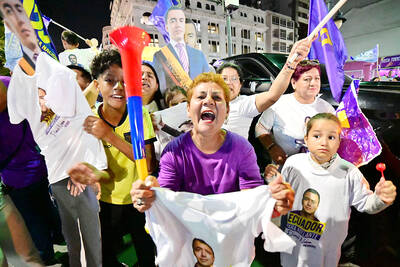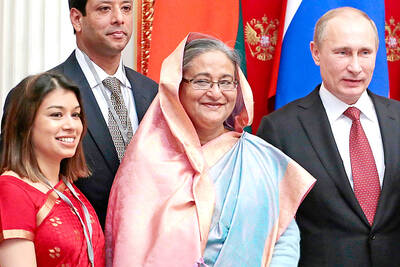An investigation was under way on Saturday into Russia's black market trade in radioactive materials amid concern that quantities of polonium 210, the substance that killed former spy Alexander Litvinenko, are being stolen from nuclear sites.
Officials from Britain's Atomic Weapons Research Establishment and Porton Down, the government's Defense Science and Technology Laboratory were trying on Saturday to track down the precise source of the polonium 210 that was used in the murder of Litvinenko.
As British police drew up a list of witnesses for questioning over the death, experts warned that thefts from poorly protected nuclear facilities in the former Soviet Union were a major problem.
A senior source at the International Atomic Energy Agency (IAEA), said he had no doubt that the killing of Litvinenko was an "organized operation" which bore all the hallmarks of a foreign intelligence agency.
Theories that the death may have involved some form of state sponsorship were being investigated by MI5 and MI6 (British intelligence and counter intelligence) who are investigating the possibility that foreign agents may have been behind the death of Litvinenko.
A senior British security source said they were providing the police with material on "hostile intelligence agencies" operating in the UK, including those from Russia.
"Russia has never really decreased their activity in the UK from the end of the Cold War," he said.
More than anything, the death of the London-based former KGB spy has placed Russia's still thriving trade in radioactive material under scrutiny.
One of the few figures available, a database compiled by researchers at Stanford University in the US, revealed that about 40kg of weapons-usable uranium and plutonium were stolen from poorly protected nuclear facilities in the former Soviet Union between 1991 and 2002.
Although the IAEA has no confirmation of polonium finding its way in to the underground trade, there have been several unconfirmed reports of thefts.
In 1993 the Bulletin of Atomic Scientists reported that 10kg of polonium had disappeared from the Sarov, which produces the rare radioactive material and is described as Russia's own version of Los Alamos, the US government's nuclear research base in New Mexico.
Globally, there have been more than 300 cases during the past four years where individuals have been caught trying to smuggle radioactive material. Last year there were 103 confirmed incidents of trafficking and other unauthorized activities involving radioactive materials, many involving Russia.

Incumbent Ecuadoran President Daniel Noboa on Sunday claimed a runaway victory in the nation’s presidential election, after voters endorsed the young leader’s “iron fist” approach to rampant cartel violence. With more than 90 percent of the votes counted, the National Election Council said Noboa had an unassailable 12-point lead over his leftist rival Luisa Gonzalez. Official results showed Noboa with 56 percent of the vote, against Gonzalez’s 44 percent — a far bigger winning margin than expected after a virtual tie in the first round. Speaking to jubilant supporters in his hometown of Olon, the 37-year-old president claimed a “historic victory.” “A huge hug

Two Belgian teenagers on Tuesday were charged with wildlife piracy after they were found with thousands of ants packed in test tubes in what Kenyan authorities said was part of a trend in trafficking smaller and lesser-known species. Lornoy David and Seppe Lodewijckx, two 19-year-olds who were arrested on April 5 with 5,000 ants at a guest house, appeared distraught during their appearance before a magistrate in Nairobi and were comforted in the courtroom by relatives. They told the magistrate that they were collecting the ants for fun and did not know that it was illegal. In a separate criminal case, Kenyan Dennis

A judge in Bangladesh issued an arrest warrant for the British member of parliament and former British economic secretary to the treasury Tulip Siddiq, who is a niece of former Bangladeshi prime minister Sheikh Hasina, who was ousted in August last year in a mass uprising that ended her 15-year rule. The Bangladeshi Anti-Corruption Commission has been investigating allegations against Siddiq that she and her family members, including Hasina, illegally received land in a state-owned township project near Dhaka, the capital. Senior Special Judge of Dhaka Metropolitan Zakir Hossain passed the order on Sunday, after considering charges in three separate cases filed

APPORTIONING BLAME: The US president said that there were ‘millions of people dead because of three people’ — Vladimir Putin, Joe Biden and Volodymyr Zelenskiy US President Donald Trump on Monday resumed his attempts to blame Ukrainian President Volodymyr Zelenskiy for Russia’s invasion, falsely accusing him of responsibility for “millions” of deaths. Trump — who had a blazing public row in the Oval Office with Zelenskiy six weeks ago — said the Ukranian shared the blame with Russian President Vladimir Putin, who ordered the February 2022 invasion, and then-US president Joe Biden. Trump told reporters that there were “millions of people dead because of three people.” “Let’s say Putin No. 1, but let’s say Biden, who had no idea what the hell he was doing, No. 2, and